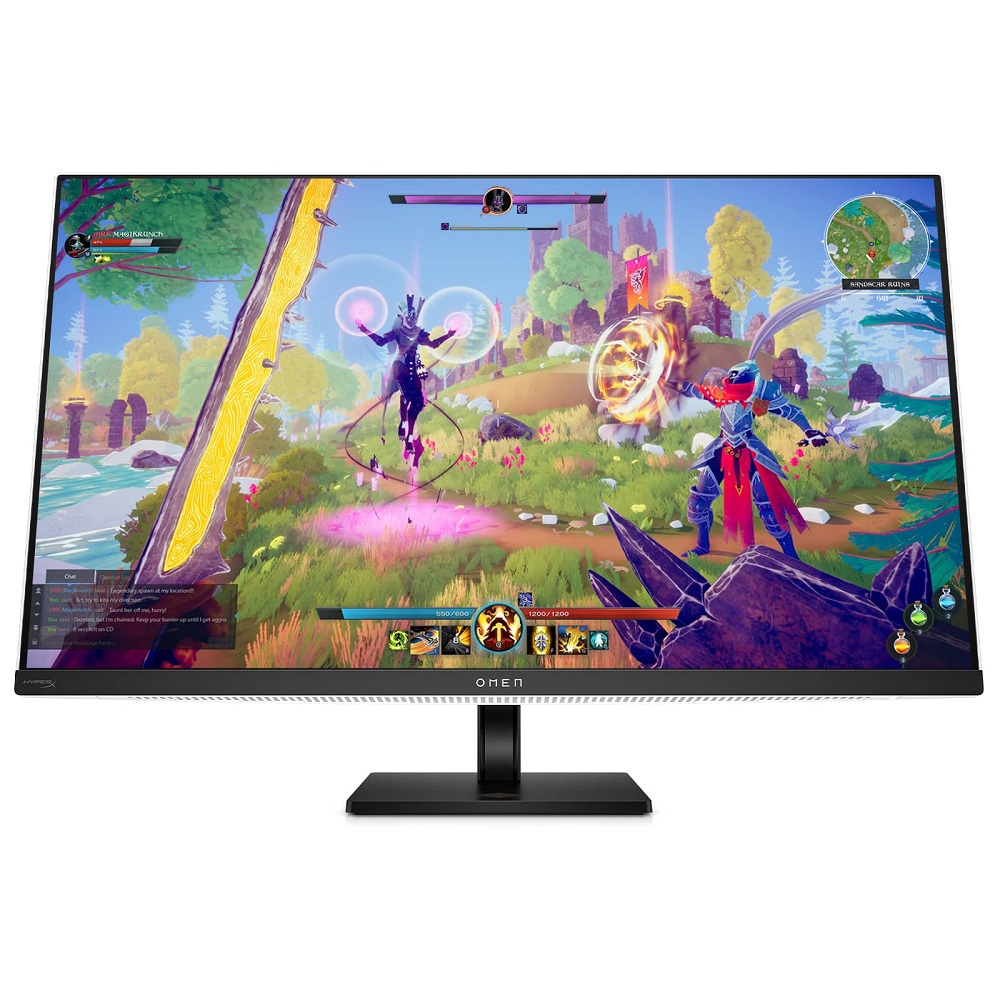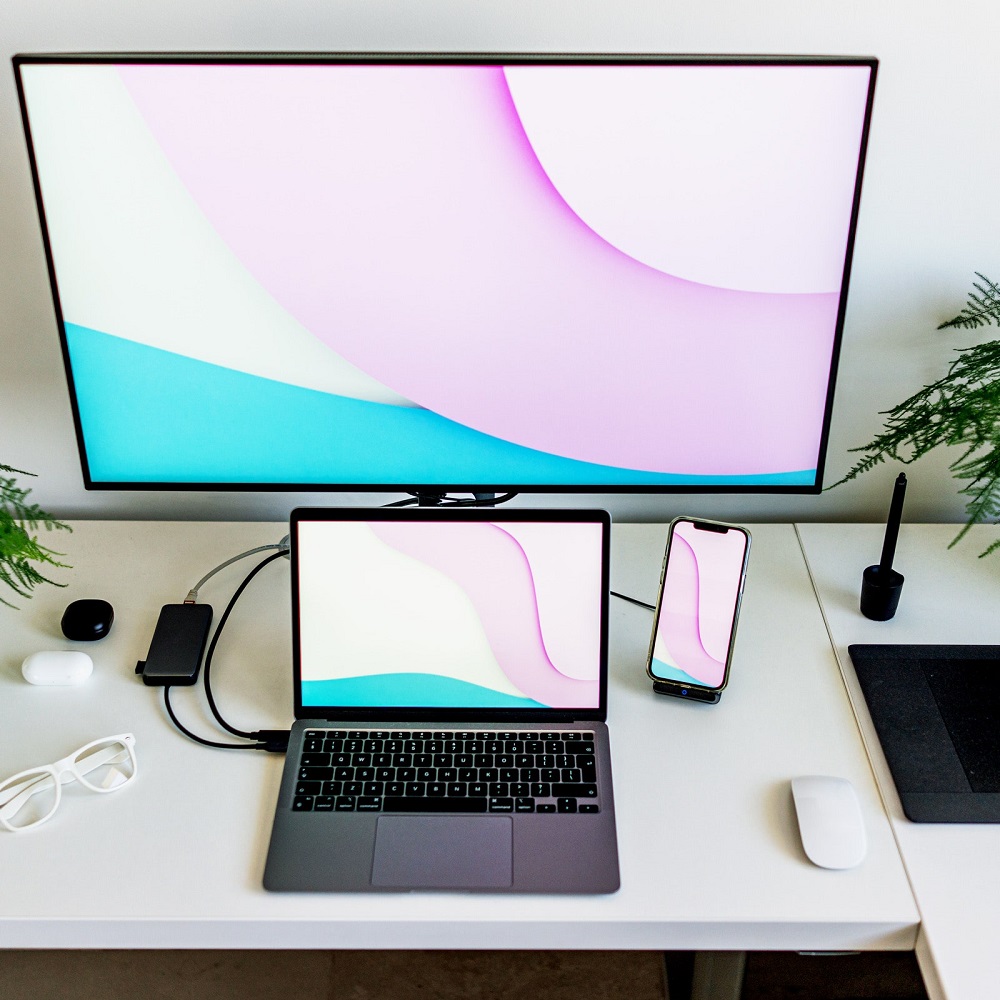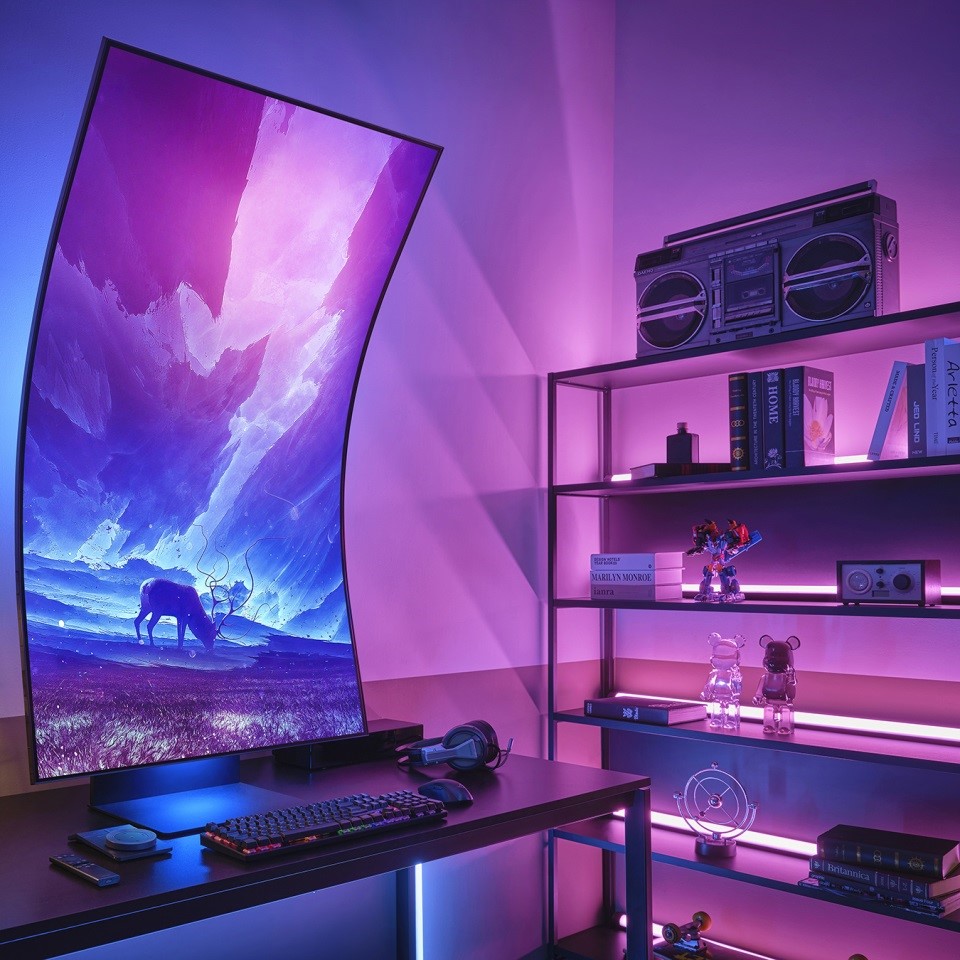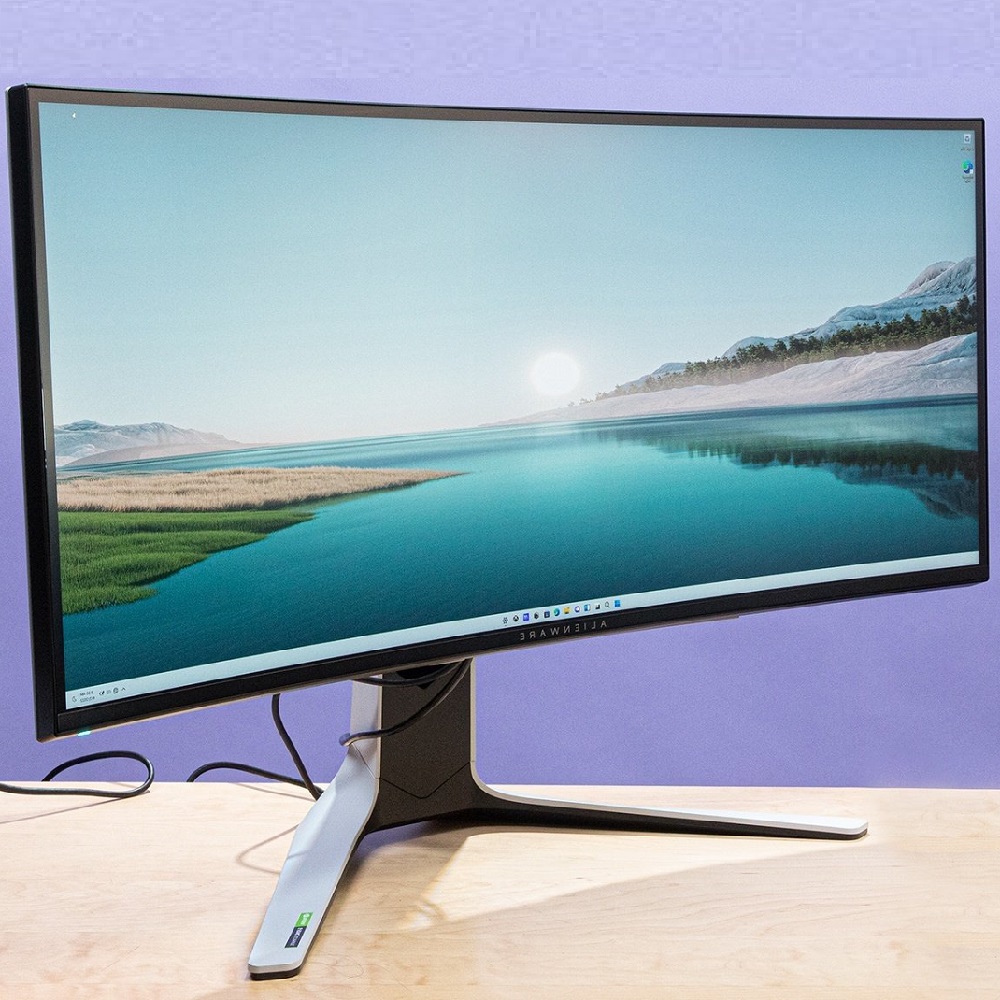Samsung’s Odyssey Neo G95C: A Gargantuan Display
Overview of the Odyssey Neo G95C’s Size and Design
The Odyssey Neo G95C stands as the titan of monitors in Samsung’s lineup. Its size at 57 inches dwarfs many others. It boasts a deep curve, rated at 1000R, wrapping the display around your field of vision. With such dimensions, it may extend beyond the edges of a standard desk. Its sturdy stand reflects the display’s scale, spanning over half its width. Samsung’s design pushes boundaries, making the G95C not just a monitor but a statement piece. It champions an immersive experience with a panoramic view that draws the player deep into the game world.
Despite its impressive size, the design maintains sleekness and the futuristic aesthetic that Samsung is known for. The curvature emphasizes focus and promotes a more engaging viewing experience. The monitor’s physical impact echoes its visual performance, commanding attention and space. As a piece of hardware, the G95C underlines Samsung’s leadership in the biggest computer screen race, balancing the spectacle of size with the precision of advanced design.
Key Features of the Odyssey Neo G95C
Resolution and Size: Raising the Bar in Monitor Displays
The Odyssey Neo G95C is a game-changer in the world of monitors with its jaw-dropping 57-inch display. Picture clarity reaches new heights with a resolution that stands at an impressive 7680×2160, effectively combining two 4K displays into one seamless panel. This gigantic screen size and ultra-high resolution redefine the meaning of expansive viewing, catering especially to users desiring the biggest computer screen.
Due to its unprecedented scale, the Neo G95C is likely to become a center of conversation for both its size and the visual impact it offers. Users can expect a display that not only dominates their physical workspace but also delivers a visual experience that is hard to match, be it for professional applications or entertainment.

Refresh Rate and GPU Requirements: Pushing the Performance Limits
In addition to its vast size, the Odyssey Neo G95C pushes the performance envelope with a blazing 240Hz refresh rate, ensuring ultra-smooth motion in the most demanding games and videos. However, powering such a beast requires top-notch hardware. Samsung has equipped this monitor with support for the latest DisplayPort 2.1 connection, which is necessary to handle the double-4K resolution at full refresh rate capabilities.
To make full use of the G95C’s capabilities, users will need to pair it with a strong GPU, such as the AMD Radeon RX 7900 series, which currently offers the required DisplayPort 2.1 feature. This signifies a requirement for both gamers and professionals to have the latest in graphics card technology to experience what this monitor can truly offer, marking another leap in the biggest computer screen race.
The Challenges of Accommodating the Neo G95C
Navigating the setup for the Odyssey Neo G95C presents unique challenges due to its massive size. A monitor this large is not just about plugging and playing. Users must plan the physical space and support structures carefully to ensure a safe and effective display installation.
Desk Requirements: Size and Durability Considerations
To start, the sheer size of the G95C means most standard desks won’t suffice. You’ll need a desk that’s not only wide, but also extremely sturdy, to accommodate and support this mammoth screen. The desk must have the depth to allow for the monitor’s dramatic curve, lest it hang off the front uncomfortably. Invest in a robust desk that can handle the monitor’s weight and dimensions for a stable setup.
Mounting Options: VESA Compatibility and Stand Design
Finding a suitable mounting arm for the G95C might be challenging. With its weight and width, standard VESA arms may struggle. Users are likely to rely on the included stand, engineered to support the monitor adequately. The stand’s design is broad, mirroring the monitor’s width to provide the necessary balance. Consider the stand’s footprint and how it will fit into your space when planning your gaming or work area.
Odyssey Neo G95C vs OLED G9: Comparing Samsung’s Titans
When it comes to the biggest computer screen options from Samsung, the Odyssey Neo G95C and the OLED G9 stand tall as formidable giants. Both screens offer unique advantages and cater to different user preferences, which makes comparing them intriguing.
OLED G9: Balance of Size and Image Quality
The OLED G9 strikes a balance between a vast display and superior image quality. It’s 49 inches wide and boasts an 1800R curve rating, less pronounced than the G95C’s curve. It offers a resolution of 5120×1440, which is akin to having two 1440p displays side by side. The true strong suit of the OLED G9 lies in its OLED panel. This technology allows for excellent color reproduction and ‘perfect blacks,’ providing an immersive experience that is hard to beat. With a refresh rate of 240Hz, it matches the performance of bigger screens, ensuring smooth gameplay and a responsive feel.
Display Technology Face-off: LCD vs OLED for Gaming
When weighing options for gaming, the battle between LCD and OLED technology is ongoing. The LCD panel of the Odyssey Neo G95C delivers a massive double-4K resolution, but the OLED G9’s panel provides exceptional contrast and color depth, thanks to its OLED technology. The OLED’s faster response time of 0.1ms is ideal for gamers needing quick reflexes, while the deep blacks enhance visual depth and realism. The LCD technology, albeit lacking the perfect black levels, offers immense screen real estate for a panoramic experience. Ultimately, the choice comes down to personal preference, whether prioritizing size and spectacle or color accuracy and contrast.
Innovative Onboard Software Integration
In the race for the biggest computer screen, Samsung isn’t just breaking records with size; it’s also pioneering with onboard software integration. The advance is clear with the Odyssey Neo G95C. Thanks to the smart software, this monitor blurs the line between a traditional display and smart entertainment center. You can access popular streaming apps directly through the monitor, no extra devices needed. This includes Netflix, YouTube, and even gaming services like Xbox Game Pass streaming and GeForce Now.
Accessing Streaming Apps Without Additional Hardware
The Odyssey Neo G95C’s ability to run streaming apps without additional hardware is a standout feature. It means less clutter and hassle for users. With streaming becoming a core part of entertainment, having direct access is a huge plus. Whether you’re taking a break from work or gaming, your favorite shows and movies are just a few clicks away. This integration removes the need for separate streaming devices, making for a cleaner setup.
The Viewing Experience: Aspect Ratio and Content Availability
While the G95C’s massive size is impressive, the unique 32:9 aspect ratio comes with considerations. Not all content fits this wide format perfectly. Samsung’s software may help find suitable content, but it’s something to think about. Users may find some movies and shows with black bars on the sides or, alternatively, stretched. Despite this, the expansive real estate of Samsung’s monitor provides a cinematic feeling hard to find elsewhere.
Future-Proof Connectivity: Embracing DisplayPort 2.1
As the biggest computer screen yet, the Odyssey Neo G95C isn’t just any display. It is a gateway to the future of connectivity. Samsung ensures this with the integration of DisplayPort 2.1. This advanced port is the lifeline for the monitor’s rich, double-4K resolution at a 240Hz refresh rate. DisplayPort 2.1 is crucial for a setup that is future-proof, ensuring that the G95C remains at the cutting edge. It’s a commitment to video bandwidth and data capabilities that far exceed older standards. This foresight caters to users who demand longevity from their tech investments.
Graphics Card Compatibility: Staying Ahead with AMD’s Radeon RX 7900 Series
The Odyssey Neo G95C’s stellar performance requires potent hardware, and currently, AMD’s Radeon RX 7900 series graphics cards rise to the challenge. These GPUs are among the first to support DisplayPort 2.1, making them the perfect pairing for the biggest computer screen Samsung has offered. The synergy between the G95C and AMD’s GPUs exemplifies a high-octane match, driving unparalleled display performance. The Radeon RX 7900 series stands as the vanguard, offering users the ability to maximize their experience of Samsung’s colossal monitor.
Preparing for the Release
As excitement builds for Samsung’s groundbreaking Odyssey Neo G95C, anticipation for its release is high. Equally, questions about the cost bubble up amongst enthusiasts, swayed by the monitor’s size and advanced features. While release dates remain under wraps, speculation suggests a debut before mid-2023. Steep pricing is expected, possibly soaring above $2000, so hopeful buyers should start budgeting.
Anticipated Launch Dates and Price Speculations
Information about the launch and price of the colossal Odyssey Neo G95C is scarce. Yet, industry trends and the premium nature of this biggest computer screen hint at a launch by mid-2023. Regarding cost, given the monitor’s pinnacle stature, the market expects a hefty price tag. Estimates advise preparing for an investment above the $2000 threshold.
Considerations for the Enthusiast: Investment and Practicality
For the tech enthusiast, the Odyssey Neo G95C represents not just a purchase but an investment. With its unprecedented size and might, the monitor demands considerations beyond price. Think about the practicality of housing such a vast screen. Analyze desk dimensions, the endurance of current hardware, and the real usage you’ll get from this epic display. Factor in the advanced features, DisplayPort 2.1 compatibility, and the future tech landscapes when making a decision. Being an early adopter has its thrills, but it’s crucial to gauge the balance between spectacle and daily practicality.


